Course objectives:
|
| To lern introduced section of plant physiology. |
Requirements on student
|
| exam in extent of the lectures |
Content
|
- Chemical Composition of Plant Body: Inorganic ions. Sugars and polysaccharides. Aminoacids and proteins. Fatty acids, fats and oils. Nucleotides and polynucleotides.
- Plant Cell: Plant Life: Unifying Principles. Overview of Plant Structure. The Plant Cell. The Cytoskeleton. Cell Cycle Regulation. Plasmodesmata.
- Cell Walls: The Structure and Synthesis of Plant Cell Walls. Patterns of Cell Expansion. The Rate of Cell Elongation. Wall Degradation and Plant Defense.
- Water and Plant Cells, Water Balance of Plants: Water in Plant Life. The Structure and Properties of Water. Water Transport Processes. Water in the Soil. Water Absorption by Roots. Gutation. Water Transport through the Xylem. Water Movement from the Leaf to the Atmosphere.
- Mineral Nutrition and Asimilation: Essential Nutrients, Deficiencies, and Plant Disorders. Treating Nutritional Deficiencies. Soil, Roots, and Microbes. Nitrogen in the Environment. Nitrate Assimilation. Ammonium Assimilation. Amino Acid Biosynthesis. Biological Nitrogen Fixation. Assimilation of Nutrients.
- Photosynthesis: General Concepts. Organization of the Photosynthetic Apparatus. Organization of Light-Absorbing Antenna Systems. Mechanisms of Electron Transport. Proton Transport and ATP Synthesis in the Chloroplast. Repair and Regulation of the Photosynthetic Machinery. Genetics, Assembly, and Evolution of Photosynthetic System. The Calvin Cycle. Regulation of the Calvin Cycle. Photorespiration. The C4 Carbon Cycle. Crassulacean Acid Metabolism (CAM). Sucrose and Starch.
- Membranes and Solute Transport and Translocation in the Phloem: Passive and Active Transport. Membrane Transport Processes. Membrane Transport Proteins. Ion Transport in Roots. Pathways of Translocation. Source to Sink. Materials Translocated in the Phloem. Rates of Movement. The Pressure-Flow Model for Phloem Transport. Phloem Loading and Unloading and Sink-to-Source Transition. Photosynthate Distribution.
- Respiration and Lipid Metabolism: Overview of Plant Respiration. Glycolysis. The Citric Acid Cycle. Mitochondrial Electron Transport and ATP Synthesi. Respiration in Intact Plants and Tissues. Lipid Metabolism.
- Secondary Metabolites and Plant Defense: Cutin, Waxes, and Suberin. Terpenes. Phenolic Compounds. Nitrogen-Containing Compounds. Induced Plant Defenses against Insect Herbivores. Plant Defense against Pathogens.
- Growth and Development: Overview of Plant Growth and Development. Embryogenesis: The Origins of Polarity. Shoot Apical Meristem. Root Apical Meristem. Vegetative Organogenesis. Senescence and Programmed Cell Death.
- Phytochrome and Light Control of Plant Development: The Photochemical and Biochemical Properties of Phytochrome. Characteristics of Phytochrome-Induced Response. Structure and Function of Phytochrome Proteins. Genetic Analysis of Phytochrome Function. Phytochrome Signaling Pathways. The Photophysiology of Blue-Light Response. Blue-Light Photoreceptors. Circadian Rhythms.
- Auxin: The Emergence of the Auxin Concept. Identification, Biosynthesis, and Metabolism of A. Auxin Transport and Action. Cell Elongation, Phototropism and Gravitropism. Developmental Effects of Auxin. Auxin Signal Transduction Pathways.
- Gibberellins: Their Discovery and Chemical Structure. Effects of Gibberellins on Growth and Development. Biosynthesis and Catabolism of Gibberellins. Gibberellin Signaling and Responses.
- Cytokinins: The Discovery, Identification, and Properties of Cytokinins. Biosynthesis, Metabolism, and Transport. The Biological Roles of Cytokinins. Cellular and Molecular Modes of Cytokinin Action.
- Ethylene: Structure, Biosynthesis, and Measurement of Ethylene. Developmental and Physiological Effects of Ethylene. Ethylene Signal Transduction Pathways.
- Abscisic Acid: Occurrence
|
Activities
|
Guarantors and lecturers
|
- Guarantors: prof. Ing. Miroslav Strnad, CSc., DSc.,
- Lecturer: prof. Ing. Miroslav Strnad, CSc., DSc.,
- Tutorial lecturer: Nuria De Diego, Ph.D., Mgr. Markéta Gemrotová, Ph.D., Ing. Jaromír Mikulík, Ph.D., Mgr. Jaroslav Nisler, Ph.D., Mgr. Aleš Pěnčík, Ph.D., Mgr. Jakub Rolčík, Ph.D., Mgr. Radim Simerský, Ph.D.,
- Seminar lecturer: Ing. Jaromír Mikulík, Ph.D., Mgr. Radim Simerský, Ph.D.,
|
Literature
|
- Recommended: Procházka, J. Fyziologie rostlin. Academia, Praha, 1998.
- Recommended: Taiz, L., Zeiger, E. Plant Physiology. Sinauer Associates, Inc., Publisher, Sunderland, Massachussets., 2006.
- Recommended: www.ibotanika.upol.cz.
- Recommended: Alberts, B., Bray, D., Johnson, A., Lewis, J., Raff, M., Roberts, K., Walter, P. Základy buněčné biologie. Espero Publishing, Ústi nad Labem, 2000.
- On-line library catalogues
|
Time requirements
|
|
Activities
|
Time requirements for activity [h] |
|
Homework for Teaching
|
5 |
| Preparation for the Exam |
25
|
| Total |
30
|
|
Prerequisites – other information about course preconditions
|
| – |
Competences acquired
|
| Student should be able to (after attending the course): – Describe the Chemical Composition of Plant Body. – Describe the Plant Cell. – Describe the Cell Walls and their functions. – Explain the Water and Plant Cells, Water Balance of Plants. – Explain the Mineral Nutrition and Assimilation of Plants. – Explain the Photosynthesis – Describe the membranes and explain the Solute Transport and Translocation in the Phloem – Describe the Respiration and Lipid Metabolism – Explain the Growth and Development – Describe the Phytochrome and Light Control of Plant Development – Characterize the Auxin, Gibberellins, Cytokinins, Ethylene, Abscisic Acid and Brassinosteroids – Explain the Control of Flowering |
Teaching methods
|
|
|
Assessment methods
|
|
|
 Laboratory of Growth Regulators
Palacký University Olomouc
Laboratory of Growth Regulators
Palacký University Olomouc